The foundation and rapid growth of the Sunday School movement in the late eighteenth century was a most important development in the education system. In Sunday Schools the “children of the poor” were taught reading and writing as well as the Scriptures and there were no fees. In Harpenden, in 1802, John Bennet Lawes (the elder) gave a cottage near St Nicholas Church for a Sunday School. Further to this, in the early nineteenth century two school societies were founded with the aim of providing cheap daily education for as many children as possible.
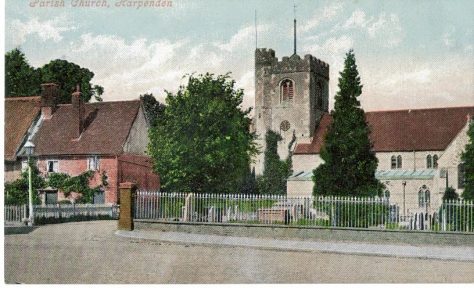
St Nicholas Sunday School and then the National School founded in 1858 were in cottages to the left of this sketch. Credit: St Nicholas School archives
Joseph Lancaster, a Quaker, had developed a system whereby he could teach up to 500 pupils by using monitors chosen from the pupils. In 1808 he founded, what became in 1810, the British and Foreign Schools Society, usually referred to as the British Society. In 1850 John Bennet Lawes of Rothamsted helped establish Harpenden’s British School on his land in what is now Park Hall, in Leyton Road.
The Reverend Andrew Bell, an Anglican Minister, had already experimented along similar lines whilst in Madras, and on his return to Britain founded the National Society for Promoting the Education of the Poor in the Principles of the Established Church, otherwise known as the National Society in 1811.
Harpenden National Mixed School
The exact date that the school opened is difficult to pinpoint, although the first official report of the Harpenden National Mixed School was for the year commencing August 9th 1858. Originally the school shared the Sunday School cottages at the front of St Nicholas Church, (just to the left of the cottages in the picture above). These had been donated by Mr. (later to be Sir) John Bennet Lawes. The school then moved to the clubroom at the back of the Old Red Lion Inn (No.72 on the High Street) whilst a new school building was erected.
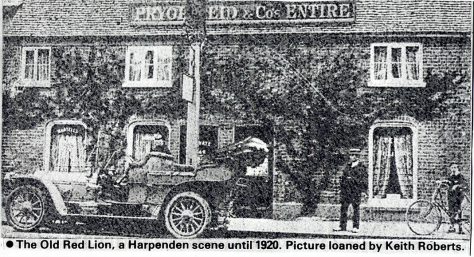
The Old Red Lion in 1904 – at 72 High Street, now the site of Billy’s bar. Credit LHS archives
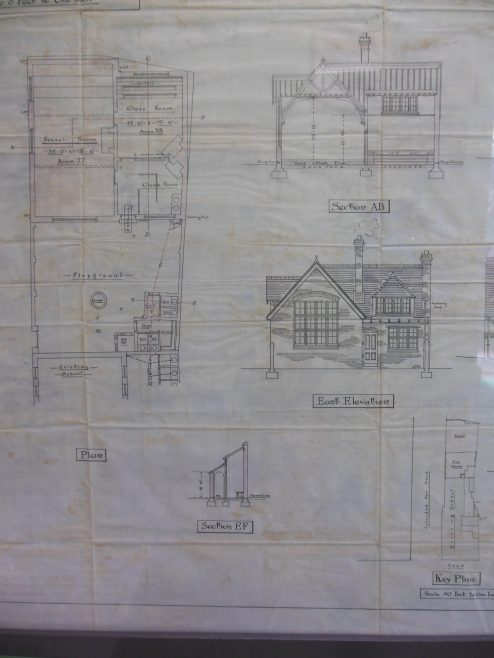
Plan for school in 1865 – left hand. Credit: St Nicholas School archives
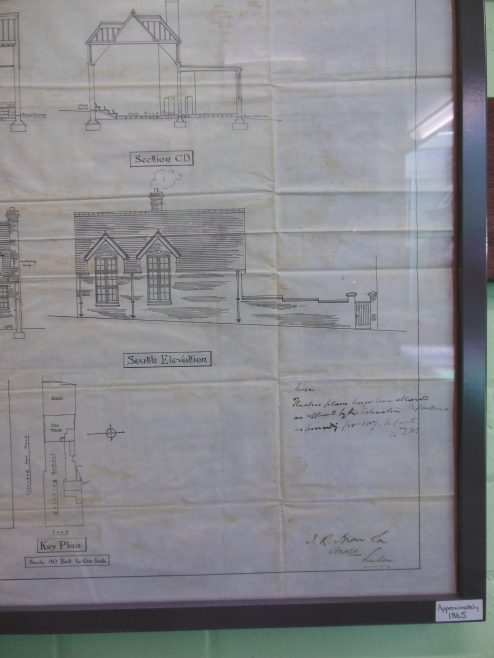
Plan for school in 1865 – right hand. Credit: St Nicholas School archives
The new school buildings, which were on the site of the former workhouse and ropeworks, were opened on 2nd January 1865. The building consisted of two rooms. The main room, which is now the school hall, housed four separate classes for children aged over six and the smaller room, now the school ICT suite, housed the infants.
At the side of the houses stood a tin hut known as the “Iron Room” or “Rector’s Room”, which can just be seen in the picture below. This was built in 1885 and formed a classroom and also doubled up as a church hall. It was on the site of where St Nicholas’ main church hall is now and remained as a tin hut, although with various improvements, until the mid 1970s.
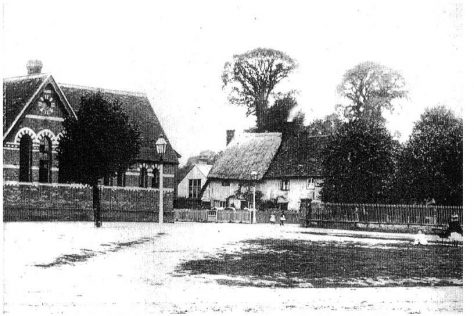
The school in 1885, showing the tin hut behind the cottages. Credit: St Nicholas School archives
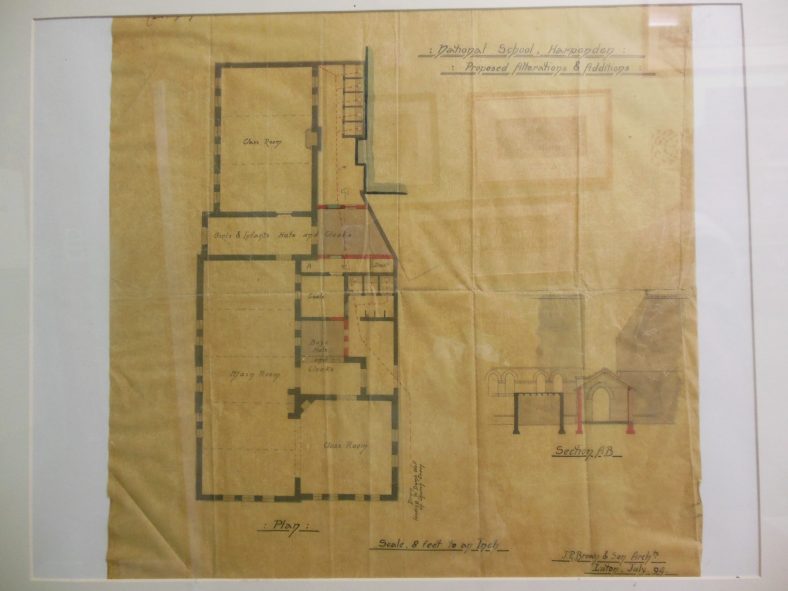
Plan for extension, 1894. Credit: St Nicholas School archives
In 1889 a further classroom, now the school resources room, was built which allowed for a further 55 infants and 45 older children. Then a detached schoolroom for the Infants was built in 1895.
Acquisition of the school site
The archives contain a transcript of the deeds relating to the purchase of the school site, including the existing cottages, on 19th February 1858. The cost of £145 was paid by Gerard Wolfe Lydekker, of Harpenden Lodge, to John Bennet Lawes, Lord of Rothamsted Manor.
In 1864 there is a further deed for the grant of the site of the National School from J B Lawes and G W Lydekker to The Incumbent and Churchwardens of Harpenden. At this time this was The Rector, Edward Thomas Vaughan, and Robert Sibley of Annables and George Burchmore of Hatching Green as Churchwardens.
This is an extensive document giving full details on how the school managers should be appointed, how often to meet, how to appoint (and dismiss!) teachers etc.
Further land was acquired in 1889.
St Nicholas Church of England Primary School – 1906
A significant event in the history of the school occurred on 1906 when all National Schools were renamed as Church of England Schools – so St Nicholas CE Primary School was created.
Further alterations and extensions to the buildings occurred over the years, with the school finally being “finished” in 1982 with an extension in the middle to join the two separate buildings. The school building was now complete and this is how it remains today.
There are very few early pictures of the school.
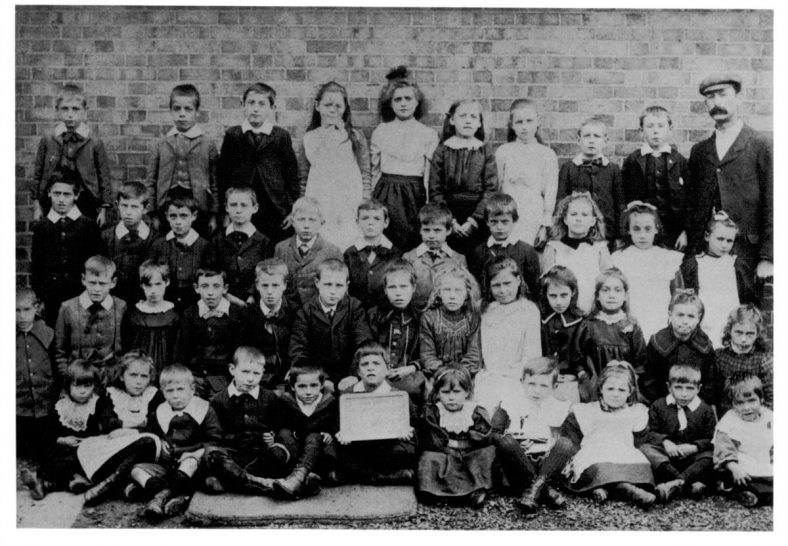
Class photo in 1909. Credit: St Nicholas School archives
This picture was taken circa 1909 and shows the Headmaster, Mr. Stephenson on the right. The girl in the middle of the back row is most likely a Monitor with responsibility for assisting with the teaching.
The Log books
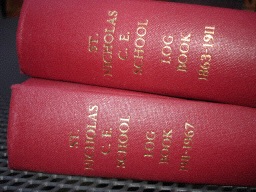
The log books – 1863 to 1967. Credit: St Nicholas School archives
Log Books had to be kept from 1863 and formed a daily record, with often just a very brief comment, of school life.
St Nicholas School log book starts on April 24th 1863 and the first entry reads “School visited by H M Inspector”.

Page from logbook, 1880. Credit: St Nicholas School archives
The Log Books form a valuable and interesting part of the school history and give an insight into areas such as attendance.
- May 11th 1863 Boy away for want of shoes
- May 15th 1863 Race Day – scarcely any children
- June 30th 1863 Holiday – Sunday school treat
- July 7th 1863 Several boys away haymaking
- July 23rd 1863 Four boys away turnip pulling
- Sept 7th 1863 Statute Fair many children absent
- Sept 28th 1863 Wet day – low attendance in consequence
- Jan 14th 1864 A boy away in consequence of falling in the pond
- Feb 17th 1864 Weather milder – consequently a greater attendance
- Apr 5th 1864 Low attendance – it snowed all day
- Nov 2nd 1866 Two children kept away to gather acorns
- Jan 4th 1876 Very cold – only twenty three children present – sat round the fire to work
- an 28th 1919 Heavy snowstorm. On Bks 218, present 73. Registers not marked this morning. The Managers have decided to close the School for the rest of the day. The children were dismissed at noon.”
Some further interesting Log Book entries:
- Dec 3rd 1863 A very windy day – part of the roof blown off the school
- Jan 7th 1864 A mouse in school caused a little confusion
- Jan 19th 1864 Many of the children with coughs – consequently a great noise
- May 24th 1905 Lessons of a particular nature this morning in celebration of Empire Day. Half holiday in the afternoon.
- Mar 4th 1910 We have put up a portrait of His Majesty King Edward VII.
- May 13th 1910 Children assembled opposite Public Hall to hear proclamation of King George V.
- June 20th 1911 School closes this evening for one week in honour of the coronation of King George V.
- July 31st 1919 Closed for Midsummer Holiday. 5 weeks, being 4 weeks ordinary holiday and 1 additional week by the wish of His Majesty the King in commemoration of the conclusion of Peace.
- Apr 26th 1923 Holiday today by the wish of the King in honour of the marriage of his son – The Duke of York.
- Feb 12th 1941 Inspected gas masks in accordance with instruction in E.C.4741 and found 11 defective (These then had to be repaired by the ARP)
- May 15th 1941 John Purney went, against my instruction, into Mr. Dunkleys’ cottage garden to retrieve a ball. His hand was slightly grazed when the dog attempted to bite him.
- Jun 5th 1953 Held a brief ceremony, involving the whole school, in the playground. Mr. A Clark, supported by the Rector, issued coronation mugs and tickets to the children.
- Jul 9th 1959 Class 3 visited Whipsnade Zoo
School Hours and School Holidays
The school day started at 9am, although for many boys their day started much earlier as they would go to work first – such as polishing shoes or running errands at big houses.
It is not clear what time of day school ended, but there is reference in the Log Book to visitors staying until 4pm. In the early 20th century Log Book entries suggest that normal school hours were 9 – 12noon and 2 – 4.15pm.
School holidays totalled 6 weeks a year – Four in the summer for harvesting, one week at Christmas and one week at either Easter or Whitsun, depending upon when Easter fell. By the turn of the century the “Midsummer Holiday” had settled down to starting on the 28 July – 3 August.
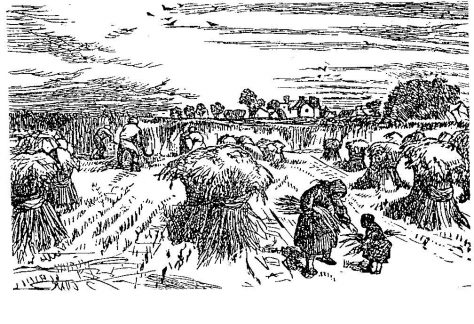
Sketch, showing children helping at harvest time. Credit: St Nicholas School archives
There was also an annual summer treat, usually in the Lydekker’s or Rectory meadow. The Rectory – now Old Rectory Close – gardens were quite extensive and reached as far as the garage on the corner of Townsend Lane.
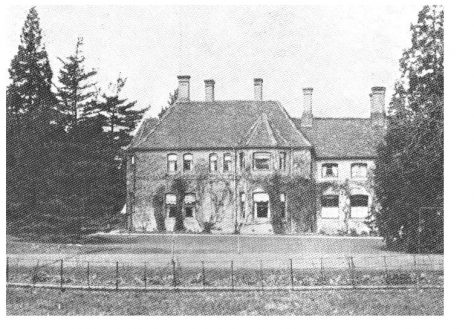
The Old Rectory, with its extensive gardens. Credit: St Nicholas School archives
There is a treat reported from 1877 – when the school broke up on 10 August the scholars enjoyed a treat in the Rectory meadow, organised by Miss Jones and her assistant teachers. Nearly 200 scholars attended, although admission was refused to those with irregular school attendance!
School Funds
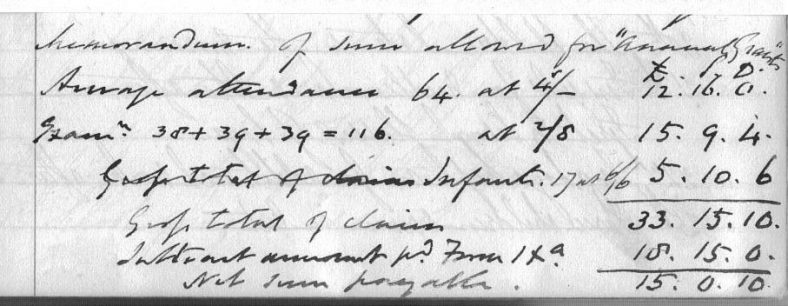
Extract from log book – fees paid in 1862. Credit: St Nicholas School archives
From 1862 government aid to schools was based numbers of children attending and their exam results. Schools were paid 4s. for every child in attendance, plus a further 2s.8d. per subject for every child who passed an exam in reading, writing and arithmetic. This can be seen from an entry in the school logbook, for 1863-64, entitled “Memorandum of sum allowed for annual grants”.

Extract from the accounts for 18. Credit: St Nicholas School archives
The average allowance was 4s. paid to 64 children. Total £12 6s. for attendance. The 2s.8d. grant was awarded to 38 children for reading, 39 for writing and 39 for arithmetic. Total £15 9s. 4d. for the examinations on the Three R’s.
There were also 17 infants (under 6 years old) who received a grant of 6s. 6d. each. Total £5 10s. 6d. for the Infants. Total grant £33 15s. 10d.
Children’s or School Pence
These Government grants, whilst intended to support the school, were found in practice to be inadequate. Therefore the school relied upon donations, subscriptions and “school pence”, also referred to as “Children’s pence”. The boys paid from one penny to one shilling and the girls one penny to six pence a week, according to their fathers’ occupation.
In 1890 the Education Act introduced new government grants based on attendance, which encouraged the abolition of “school pence”.
The 1902 Education Act meant the establishment of council schools which abolished School Boards, which had managed each school, and voluntary payments. Instead they provided for the funding of schools from local rates. St Nicholas might not have had a “school board” as referred to in the Act, but did have a board of Managers who ran the school – most probably the equivalent of the Board of Governors today.
St Nicholas School was officially taken over by the County Council on 30 September 1903.
School Staff
Pupil teachers, or Monitors
The Pupil Teacher scheme was introduced and available to all schools from 1846. It allowed for a competent pupil, aged 13 or over who was physically fit, could read fluently, write neatly, spell and punctuate correctly…., to assist a qualified teacher and in return they would receive some basic teacher training.
This would then give them the opportunity to progress to being a certificated (fully trained) teacher and from then a few might progress to college which would give them more career option within teaching such as being a Headmaster or Governess (Headmistress).
Pupil Teachers, or Monitors as they were sometimes called, were used at St Nicholas School and are referred to in the Log Books:
Oct 25th 1872 The Pupil Teachers generally take the lower four classes
Nov 1st 1872 On Tuesday my second PT received a telegram to go home to her mother who was dying & is now dead so the PT has not returned
Nov 8th 1872 The Pupil Teacher who went away has not returned. (Eventually she returned on 22nd November)
Masters and Mistresses
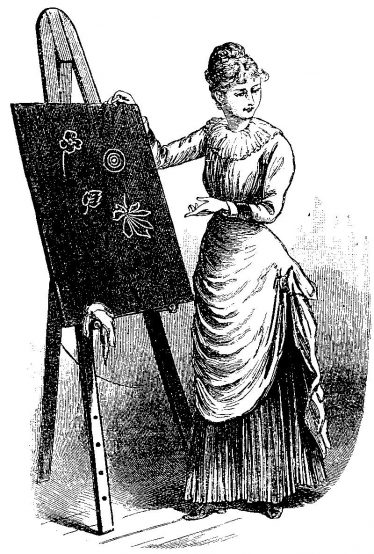
Sketch of a teacher. Credit: St Nicholas School archives
1858 – 1863 Mr. and Mrs John Gilbert were Master and Mistress of St Nicholas School, assisted by Miss Jane Gray who taught the infants.
1863 – 1868 Miss Jane Gray ran the school with the help of one Pupil Teacher and two monitors. Towards the end of her time at school Miss Gray was often assisted by Rev. E T Vaughan and one of his daughters.
1868 – 1893 Miss Charlotte Jones ran the main school with the assistance of two pupil teachers and two monitors.
1876 – Miss Anne Norton ran the Infants school with the assistance of one pupil teacher.
1889 Miss Charlotte Jones (Teacher), Miss Mary Anne Pearce (Assistant, Infants), Miss Beatrice Luck (Assistant), Margaret Taylor (Qualified), Annie Hawkins (Pupil Teacher of 2nd year), Miss Hannah Bodsworth (Assistant), Alice Bruton and Emma Jarman (Monitresses).
In 1893 it was decided that the size of the school (now 313 scholars on the books) required a Master to be in charge, with a wife to supervise the female teachers and teach needlework, as well as an Infants’ teacher.
1894 George Stephenson (Headmaster), Mrs. Stephenson (Sewing Mistress), Assistants: Miss Morgan (Infants), Miss Bodsworth, Miss Taylor, Miss Bruton, Pupil Teachers: E Jarman, Eva Steabbern, Adelaide Young
1905 Francis George Saunders (Headmaster), Class1 Mr. Wicks, Class 2 Mrs. Grantham, Class 3 Mr. Cornell, Class 4 Miss Hoare, Class 5 Miss Adcock, Class 6 Miss Hamlyn
In the early days it was a requirement that all schoolmistresses were “Miss”. As soon as any of the Mistresses got married they would either have to leave teaching, or keep their marriage a secret – all very well until they started a family! This “rule” was relaxed during WWII to ensure adequate teaching and support staff given the overall war effort.
- Feb 17th 1882 On Monday and Tuesday the Monitor was away not being well
- July 26th 1890 Mistress away on Monday with the Choir
- May 21st 1894 Kate Freeman is Monitress in Infants Dept
- Sept 14th 1908 Miss Bodsworth is unable to be present having been run down by a cyclist.
Punishments
Entries from the Log Book suggest that this was taken very seriously. “Blotting your copybook” was one of the most common and serious offences!
- Dec 2nd 1863 4 boys kept in for coming late
- Jan 4th 1864 A boy punished for blotting his copybook
- Jan 12th 1864 A boy punished for carelessly blotting his copybook
- Mar 22nd 1864 Two boys punished for playing truant
- Jan 20th 1864 A girl blotted her copybook
- Mar 15th 1865 Three boys kept in for additional work after school in consequence of carelessness at arithmetic
- Aug 10th 1869 Kept in 3 children for saying bad word
Punishment usually took the form of being kept in for minor misdemeanors or a ruler across the knuckles. For more serious offences such as inattention, disobedience, talking in lessons and truancy, caning and even expulsion was the outcome.
The curriculum
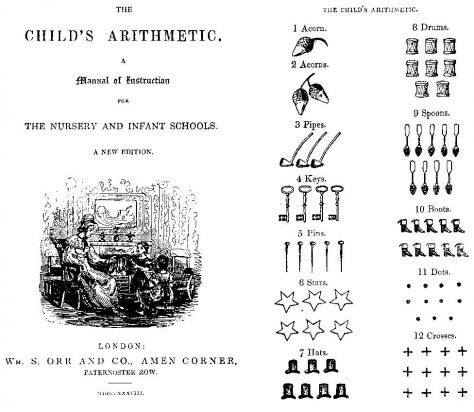
Arithmetic primer. Credit: St Nicholas School archives
The main studies were the “Three R’s” – reading, writing and arithmetic, each of which had 6 grades.
Other subjects were:
Religious Studies,
Knitting, which was popular with both girls and boys
Straw Plaiting: two sessions a week instead of sewing was allowed until 1867 in order to compete with the Plaiting Schools.
Needlework, which formed an important part of the school curriculum.
The girls wore white cotton pinafore style aprons over their dresses, which many of them would have made and/or embroidered themselves.
These can be seen in many of the old pictures, including the one below dating from about 1904.
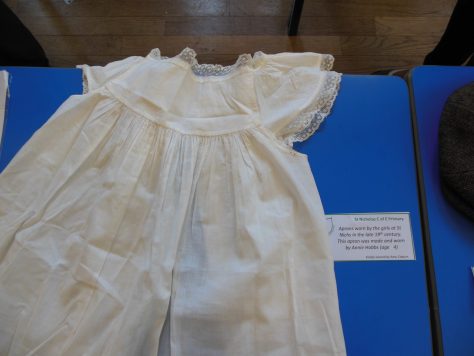
Girl’s apron from Amy Coburn’s collections. Credit: Rosemary Ross, July 2014
After the 1902 Education Act, when Hertfordshire County Council became responsible for the school, there were seven standards, or classes. These were: “Three R’s”, History, Geography, Physical Training and Needlework.
In addition to this the lower classes learnt elementary science whilst the upper classes were taught nature studies.
The First World War
During WWI children under 14 were allowed to leave school to help in the war effort. In 1916 the school summer holiday was extended by one week to cover harvest time and in 1918 the pupils gathered 12¼ cwt (637kg) of blackberries!
A plot of land in Avenue St Nicholas was worked on by the Upper standard boys from March 1917. It is not clear what they grew other than potatoes, parsnips and spring cabbage, some of which was distributed amongst the boys who had worked the plot and some sent to the local hospital. In 1918 they extended their work by digging over the gardens of a soldier at the front and of the school nurse.
In October 1918 there was a severe outbreak of influenza which affected over half of the children at school. The School Medical Officer shut the school for an initial 2 weeks, and then a further 1 week to allow recovery from flu and its after effects.

Extract from log book for 1917, including National Baby Week. Credit: St Nicholas School archives
In 1919 the assistant master, Mr. F R Smith, returned from military duties and he was “accorded a hearty reception by children, teachers and managers.”
WWII
On the outbreak of the Second World War in 1939 the school was shut from 4 – 21 September. The head teacher writes “I, Lewes James Simpkin, would have, under normal circumstances, opened school today as first head teacher of the newly organised Junior Mixed and Infants Department, but owing to His Majesty’s Government declaring war on Germany yesterday schools are closed until further notice. I appeared at the school at 8.45am collected correspondence and then went on to my duties with the Govt. Evacuation Scheme”.
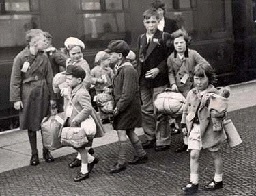
Evacuees arriving. Credit: St Nicholas School archives
Three London schools (Hugh Myddleton Central School, Clerkenwell, Crondall Street School and Medburn School, Somerstown) were evacuated to Harpenden. Their classes were distributed amongst the local schools so that Harpenden schools worked on Mondays, Wednesdays and Fridays and the London Schools on Tuesdays, Thursdays and Saturdays – which was not a popular arrangement as far as Saturdays were concerned.
In July 1940 some 250 pupils from Clive Vale School, Hastings arrived and were shared between St Nicholas and the High Street Methodist Church. However many evacuees soon returned home so that by 1942 those remaining from Hastings had reduced to just 25 all of whom went to St Nicholas.
Due to coal shortages, heating proved a problem and the school was closed for periods during the winters of 1940, 1942 and 1945.
Air Raids caused a major disruption to the school day, with many mentions being made of hearing the planes overhead. If an Air Raid occurred at lunchtime it usually had an adverse affect on afternoon attendance, as it was unsafe to travel back to school in time.
Two air raids over Harpenden occurred in 1940, the nearest bomb being ¾ mile away from the school. The Log Book tells us “….at about 2.40pm an enemy machine dropped a number of small bombs on Harpenden…No warnings were given although the machine circled around for nearly an hour…..”.
Nevertheless Air Raid precautions included sticky brown paper and blackout curtains for the windows. The girls’ air-raid shelter was the lobby, which was appropriately reinforced, just inside the girls’ entrance in Rothamsted Avenue.
The pupils were encouraged to support the war effort through working gardens, growing vegetables and salad, gather blackberries and to support “Warship Week” 1942 and “Wings for Victory” in 1943. In respect of “Wings for Victory” week the school and parents raised over £144.
School Meals
In the early days children would bring their own lunch with them, often consisting of a potato that they would put in the fire to bake. This would have then become a packed lunch with sandwiches.
In 1940 the question of a school canteen was raised and on 23 January 1941 the “Dinner Club” served its first meals to 125 pupils, 57 outsiders and 68 evacuees. It is thought that, even at that time, this was in the “Rector’s Room” which is now the church hall.
School milk started in 1926 on the initiative of Mr. F Gingell, the local dairy manager, though nationally it wasn’t introduced until 1931.
School Houses and Sports Day
On the 23rd June 1955 it is recorded that the PTA presented a silver cup, cost £2 12s 6d, to the school. The Log Book entry says “This is to be competed for fortnightly for work – on a house basis. All classes divided into 4 teams. St Andrew, St David, St George, St Patrick.”
The choice of these same Houses when the House system was revived in 2006 was pure coincidence!
Sport’s Day is worth recording just to prove that some things never change! On 25th June 1965 the Log Book records “The School Sports, postponed from Wed 23rd June were held at Rothamsted Park. The proceedings were cut short by rain.” This had also been the problem in 1963 when “rain interfered” and Sports Day had to be finished the next morning.
Winners
- 1955 St Andrew’s
- 1956 Draw between St Andrew’s and St George’s Houses.
- 1958 St Andrew’s
- 1961 St Patrick’s
- 1964 St Patrick’s
- 1965 St Patrick’s
- 1966 St Andrew’s
- (1957, 1959, 1960, 1962, 1963 and 1967 winners not recorded, the log book ceases at 1967)
In more recent years the winners have been:
- 2006 St David’s
- 2007 St Andrew’s
Parent Teachers Association (PTA)
St Nicholas PTA was formed in July 1943 making it one of the oldest in the country. It has always existed to support the school both financially and through the parents giving their time for various activities.
One of the first fundraising activities was a “Social at School” in May 1944. During this event there was a “Raffle of Eggs” which raised 12 shillings!
The current, very successful, annual Christmas Fair was perhaps preceded by annual Jumble Sales and “Bring and Buy” sales. In February 1954 the Jumble Sale was particularly successful and raised £36 11s 10d. The old PTA minutes often suggest that, if there was a large expenditure imminent, they would arrange another Jumble Sale!
Some interesting purchases by the PTA were:
- £1 5s 6d spent on “Knickers” in 1954
- 42 pairs of football shorts in Sept 1956 at a cost of £12 12s
- £14 17s spent on an electric tea urn in July 1961
- The school library was created in 1954 when the PTA presented a cheque for £20 to purchase books.
In 1964 the PTA purchased a “good garden seat” at a cost of £18 13s which they presented to the School on Prize Day (just before the end of term in July). This was to commemorate the Centenary of the School, although this was based on the opening of the “new” school building in 1864 rather than the original establishment of the Harpenden National School in 1858.
The PTA maintained a busy schedule of events with frequent visits to plays, exhibitions and places of interest, visiting speakers, social events, jumble sales and support provided in the form of school prizes, books, equipment and arranging the entertainment for the Christmas Party to name but a few.
The PTA continues to play an important and active part, in supporting the school and enhancing the children’s education.

No Comments
Add a comment about this page